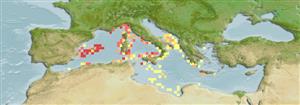>
Gobiiformes (Gobies) >
Gobiidae (Gobies) > Gobionellinae
Etymology: Buenia: Taken from Odon de Buen y del Cos, politician and Spanish naturalist; 1863-1945; lombartei: Named for Dr. Antoni Lombarte, researcher of the Institut de Ciències del Mar-CSIC, Barcelona.
Eponymy: Don Fernando de Buen y Lozano (1895–1962) (See DeBuen & also see Odón de Buen) Dr Antoni Lombarte is an evolutionary marine biologist and ecologist. [...] (Ref. 128868), visit book page.
Environment: milieu / climate zone / djupintervall / distribution range
Ekologi
marina bottenlevande; djupintervall 343 - 375 m (Ref. 117412). Subtropical; 13°C - 13°C (Ref. 117412)
Mediterranean: Spain.
Size / Vikt / Age
Könsmognad: Lm ? range ? - ? cm
Max length : 2.8 cm SL hane/ej könsbestämd; (Ref. 117412); 2.6 cm SL (female)
Short description
Bestämningsnycklar | Morfologi | Morfometri
Taggstrålar i ryggfenan (totalt) : 7; Mjukstrålar i ryggfenan (totalt) : 9; Taggstrålar i analfenan: 1; Mjukstrålar i analfenan: 7 - 8. This species is distinguished by the following characters: the anterior oculoscapular canal is semi-closed with pores ?, ?, ?, ?, ? and additional pores and open furrows; (2) suborbital row c of 6 papillae; A I, 7-8; LL 25-27; TR 6; P 18; D1 II, with the longest spine of D1, backwards reaching to D2 middle in males when folded down, in females not reaching D2 I; pelvic disc anterior membrane reduced to less than 1/6 of spinous ray in midline depth; well developed tongue bilobed; head length 33.1-35.0 of SL; eye 32.9-33.5% of head length; anal fin base 11.7-12.2% of SL; pelvic to anus 19.4-20.4% of SL; snout 72.1-75.0% of eye diameter; pectoral fin 20.2% of SL; cheek depth 15.4-15.7% of head length; colour when fresh reduced to rarely scattered yellow dots and miniature melanophores densely distributed on head and body, only forming three small marks visible at lateral midline; colour when preserved reduced to scattered miniature melanophores on head and body, forming only three small marks visible at lateral midline (Ref. 117412).
Body shape (shape guide): elongated; Cross section: oval.
Life cycle and mating behavior
Könsmognad | Reproduktion | Lek | Ägg | Fecundity | Larver
Kovačić, M., F. Ordines and U.K. Schliewen, 2018. A new species of Buenia (Perciformes: Gobiidae) from the western Mediterranean slope bottoms, the redescription of Buenia jeffreysi and the first Balearic record of Buenia affinis. Zootaxa 4392(2). (Ref. 117412)
IUCN Red List Status (Ref. 130435: Version 2025-1)
Threat to humans
Harmless
Human uses
Verktyg
Special reports
Download XML
Internet-källor
Estimates based on models
Phylogenetic diversity index (Ref.
82804): PD
50 = 0.5625 [Uniqueness, from 0.5 = low to 2.0 = high].
Bayesian length-weight: a=0.00724 (0.00338 - 0.01553), b=3.05 (2.87 - 3.23), in cm total length, based on LWR estimates for this (Sub)family-body shape (Ref.
93245).
Trofisk nivå (Ref.
69278): 3.1 ±0.5 se; based on size and trophs of closest relatives
Resiliens (Ref.
120179): Hög, lägsta populationsfördubblingstid mindre än 15 månader (Preliminary K or Fecundity.).
Fishing Vulnerability (Ref.
59153): Low vulnerability (10 of 100).
🛈
